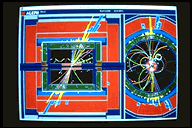
To study the basic particles of matter requires some detective work. First you must follow the trails left by the invisible particles, then you have to identify them and finally you have to put them all together to decide what happened "at the scene of the crime".
To make the particle trails visible, we need to send the particles through a detector containing a suitable substance. This can be a solid, a liquid or a gas. In a detector used in early research in particle physics, called a cloud chamber, trails of droplets form along the tracks left by particles, rather like the vapour trails of aeroplanes.
To learn about particles, we need to be able to recognise the trails left by different
types of particle. One trick we can play to help us is to make the particles pass through
a magnetic field. Particles with positive electric charge will bend one way, those with
negative charge will bend the opposite way. But the particles help us as well, because
some of them leave very distinctive trails so that we can recognise them.
 |
In a bubble chamber, for example, where particles leave trails of bubbles in a liquid, we recognise electrons when they produce delicate curling, branched tracks, unlike those of any other particle. |
| Most modern particle detectors do not make the tracks of particles directly visible. Instead, they produce tiny electrical signals that can be recorded as computer data. A computer program then reconstructs the patterns of tracks recorded by the detector, and displays them on a screen together with information from other kinds of particle detector. |  |
© Copyright CERN - Last modified on 1997-12-04 - Tradotto da Sofia Sabatti